Rosenheim is a Landkreis (district) in the south of Bavaria, Germany. Neighboring districts are, clockwise from the west, Miesbach, Munich, Ebersberg, Mühldorf, and Traunstein, with the Austrian province Tirol across the southern border. The district entirely surrounds the city of Rosenheim, which is independently administered but hosts the district's administration; both the city and the district share the "RO" designation for their license plates.
Bad Tölz-Wolfratshausen is a Landkreis (district) in Bavaria, Germany. It is bounded by Austria and the districts of Garmisch-Partenkirchen, Weilheim-Schongau, Starnberg, Munich and Miesbach.
Fürstenfeldbruck is a Landkreis (district) in Bavaria, Germany. It is bounded by the city of Munich and the districts of Munich, Starnberg, Landsberg, Aichach-Friedberg and Dachau.
Munich is a Landkreis (district) in Bavaria, Germany. It borders the districts of Dachau, Freising, Erding, Ebersberg, Rosenheim, Miesbach, Bad Tölz-Wolfratshausen, Starnberg, Fürstenfeldbruck, and almost encircles district-free city Munich itself, which is the district seat.
Starnberg is a Landkreis (district) in the southern part of Bavaria, Germany. Neighboring districts are Fürstenfeldbruck, Munich, Bad Tölz-Wolfratshausen, Weilheim-Schongau and Landsberg.
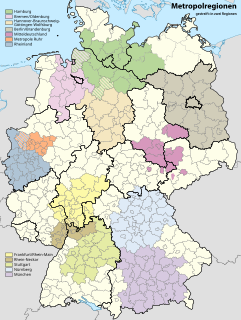
The Central German Metropolitan Region is one of the officially established metropolitan regions in Germany. It is centered on the major cities of Leipzig and Halle, extending over Central German parts of the states of Saxony-Anhalt, Thuringia and Saxony. The Central German metropolitan region is the only one located entirely within the former East Germany. The "region" is not actually a metropolitan area in the geographic sense of the word as an agglomeration of nearby urban areas, rather it is a registered association, the Europäische Metropolregion Mitteldeutschland e.V. whose membership is composed of towns, cities, municipalities, and companies, colleges and chambers of commerce in the central German geographic area, whose representatives vote upon new members. For example, Jena joined the Metropolitan Region in 2009. The registered association owns the management company Metropolregion Mitteldeutschland Management GmbH. As such it forms a planning and marketing framework for the region while retaining the legal independence of its members.

Lake Starnberg, or Starnberger SeeGerman pronunciation (help·info)) — called Lake Würm, or Würmsee, until 1962 — is Germany's second-largest body of fresh water, having great depth, and fifth-largest lake by area. It and its surroundings lie in three different Bavarian districts, or Landkreise. The lake is property of the state and accordingly managed by the Bavarian Administration of State-Owned Palaces, Gardens and Lakes.

Eggenstein-Leopoldshafen/BW is a municipality of almost 17,000 inhabitants located in the federal state of Baden-Württemberg in the Federal Republic of Germany. It lies about 12 km north of Karlsruhe and is the site of the northern campus of the research centre Karlsruhe Institute of Technology (with the former Forschungsreaktor 2. In the west, Eggenstein-Leopoldshafen borders on the Rhine River and in the east it is connected with the Bundesstraße 36.

Olching is a town in the district of Fürstenfeldbruck, in Bavaria, Germany. It is situated approximately 20 km (12 mi) northwest of Munich.

Eching is a municipality in the district of Freising, in Upper Bavaria, Germany.

Lubliniec County is a unit of territorial administration and local government (powiat) in Silesian Voivodeship, southern Poland. It came into being on January 1, 1999, as a result of the Polish local government reforms passed in 1998. Its administrative seat and largest town is Lubliniec, which lies 54 kilometres (34 mi) north-west of the regional capital Katowice. The only other town in the county is Woźniki, lying 45 km (28 mi) north-east of Lubliniec.
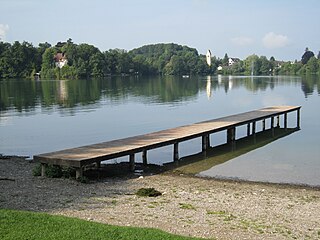
Weßling is a municipality in the district of Starnberg in Bavaria, Germany.
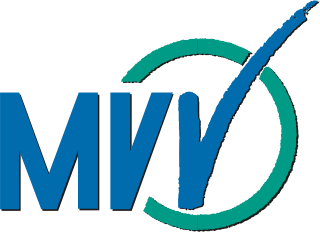
The Münchner Verkehrs- und Tarifverbund is the transit authority of the city of Munich, the capital of the German state of Bavaria. Its jurisdiction covers the city and its surrounding area, responsible for the Munich S-Bahn commuter trains, the Munich U-Bahn, the Munich tramway and buses.

Dvorce is a municipality and village in Bruntál District in the Moravian-Silesian Region of the Czech Republic. It has about 1,300 inhabitants.
Rostock is a district in the north of Mecklenburg-Vorpommern, Germany. It is bounded by the district Nordwestmecklenburg, the Baltic Sea, the district-free city Rostock and the districts Vorpommern-Rügen, Mecklenburgische Seenplatte and Ludwigslust-Parchim. The district seat is the town Güstrow.

The Langwieder lake district is composed of three lakes west of Munich in Bavaria, Germany. It opened in the year 2000 as a recreational area enclosing the Langwieder See, the Lußsee, and the Birkensee. The entire site spans 120 hectares ; 40 of which are the lakes and 80 are land; 27 hectares of which are lawns for sunbathing.
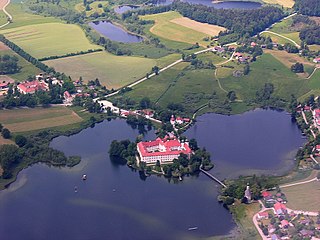
Seeon Lakes is a small group of kettle lakes in Bavaria, Germany. It is located 4 kilometres (2.5 mi) north of Lake Chiemsee in the district of Traunstein. The lakes are protected as the nature reserve Seeoner Seen. On the main lake Seeoner See is a field station for limnological research from the University of Munich, Faculty of Biology.
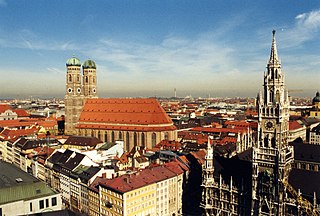
The Munich Metropolitan Region is one of eleven metropolitan regions in Germany, consisting of the agglomeration areas of Munich, Augsburg, Ingolstadt, Landshut, Rosenheim and Landsberg am Lech. It is Germany's fifth most populous metropolitan region after the Rhine-Ruhr Metropolitan-Region, the Frankfurt Rhine-Main-Region, the Berlin-Brandenburg Metropolitan-Region and the Stuttgart Metropolitan-Region.

The following outline is provided as an overview of and topical guide to Munich:

The Munich gravel plain is an Outwash plain in Upper Bavaria, Germany, formed during Late Pleistocene glacial periods. Characterized by its very wide extension, it comprises sandur terraces and the floodplain of the Isar river. These most recent deposits overlie the Neogene Molasse basin of the Alpine Foreland, which in contrast comprises fine-grained fluviatile and lacustrine facies.















